
Hey boys and girls, we had the pleasure of a chat with the director of the delightful, star-studded dramedy, The Seaside Motel. Kentaro Moriya spoke about his all-star cast, shooting in 18 days, Robert Altman and Oyasumi Punpun.
Dig it!
The Seaside Motel
Kentaro Moriya
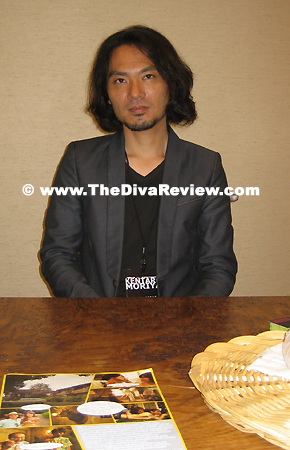 The
Lady Miz Diva: What is it like to greet the New York audience watching
The Seaside Motel here at the Japan Cuts festival?
The
Lady Miz Diva: What is it like to greet the New York audience watching
The Seaside Motel here at the Japan Cuts festival?
Kentaro Moriya: Well, I was in the auditorium with the audience and I saw a little bit of what it was like and they laughing a lot; and I just was so moved by the reaction. I actually showed this film in May earlier this year in Italy, but it was a much better reaction this time.
LMD: How did the The Seaside Motel come to you?
KM: The original story is a comic book, but of course I changed the story around a lot. The first idea was that I loved Robert Altmanís ensemble films and thatís what I wanted to do. I wanted to kind of create a space where thereís many characters just mixing about and thatís what I wanted to capture, and luckily I happened upon this comic book.
LMD: I loved all the characters in the film and I wondered how you judged how much time to spend on each one?
KM: Actually, it took me six months to write the first draft of the screenplay, then after that, it took me another year before the film began, so it was a year and half of production. Of course, I usually worked with music videos and commercials, so I was still working while I was writing.
LMD: Was there one story or story you wished you couldíve spent more time on?
KM: Well, I could only shoot for 18 days, so what I shot I used entirely. So what I had in mind, I captured and used.
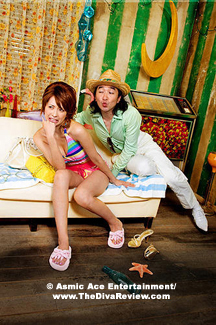 LMD:
The look of The Seaside Motel reminded me of comic book panels and I
wondered if that was what you had in mind when you planned the film?
LMD:
The look of The Seaside Motel reminded me of comic book panels and I
wondered if that was what you had in mind when you planned the film?
KM: I love comic books. I have always loved them ever since I was a kid, so when I was capturing the visual, it was sort of an innate sense of comic books. It was just a natural part of me that aesthetic of comic books.
LMD: Did you use storyboards for this film?
KM: No, actually, I did not use a storyboard. I usually do when Iím doing commercials, but for film, I donít really like to. And especially for this film, there were so many famous actors from Japan, so I did not want to interrupt their movements. So I just had to let them go about freely and edit later.
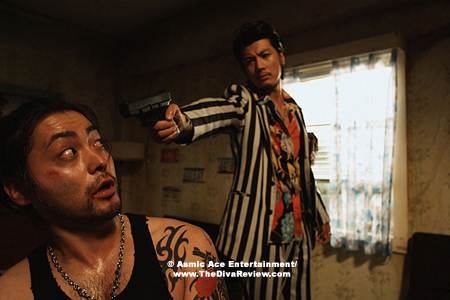 LMD:
Regarding having so many stars in the cast; how did you approach them
and what was their reaction when they read this very fast-moving script?
LMD:
Regarding having so many stars in the cast; how did you approach them
and what was their reaction when they read this very fast-moving script?
KM: That was a good question, because actually people perceive this film to be quite big budget, but itís actually not. Itís very low budget. And I did not go about this expecting such a great cast. What happened was I pitched the story and they loved it so much and one after another, they started joining my cast. And the great thing was for instance, Mr. {Takayuki} Yamada is friends with Tetsuji Tamayama and so he {Yamada} sort of invited him so they could do this movie together.
Mr. Yamada actually loved the storyline and when I told him what it was about and how he has to spend a significant potion of the film without his shirt on, he trained quite a lot.
LMD: Having interviewed him a couple of weeks ago I was surprised how at slim he was after seeing how much bigger he is in your film. I thought it was CGI.
KM: He was like Robert De Niro. {Laughs}
LMD: In The Seaside Motel, right from the name of the hotel, which is nowhere near a seaside, none of the characters get what they think theyíre getting. I wondered if that was a prevailing theme in your mind that they had to make the best of what they had?
KM: Absolutely. All of the characters in the film are deceiving one another, that is the whole point, and particularly the last shot of the ocean, when two characters you donít expect end up together. From a storyline point of view, itís a little off, but I really wanted to deceive the audience. I played a little trick on my part.
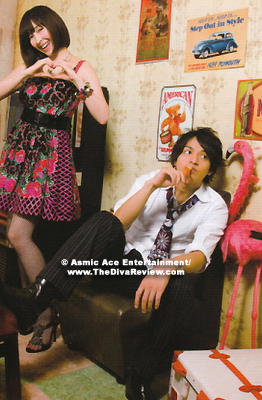 LMD:
The movie is incredibly funny, but itís also quite sad in that it
doesnít seem like anyone gets quite what they want. Were you worried
about how the audience would react to that?
LMD:
The movie is incredibly funny, but itís also quite sad in that it
doesnít seem like anyone gets quite what they want. Were you worried
about how the audience would react to that?
KM: One of my life philosophies is not everything in life will go well, and I think thatís represented by the two lovers in the film: Theyíre sort of mismatched and their timing doesnít really coincide. But the whole point is in the last scene of the film, he goes to the ocean, and even though heís this sort of dirt bag, he found something to believe in and he will wait for her forever and thereís some positivity in that, as well. I think thatís a major theme, as well.
LMD: That explanation gives it so much more hope. I was so sad when she walked back into his motel room and it was empty.
KM: Well, in the story of a man and a woman, just because they love each other doesnít mean theyíll end up together, you know? People pass each other by all the time. Some of us end up together, but not always. I think thatís what life is all about.
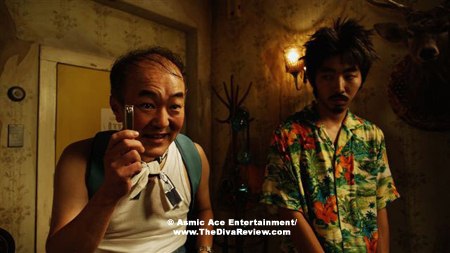 LMD:
Because there is such sadness in the missed opportunities in the film,
how did you judge how you placed the humour in it?
LMD:
Because there is such sadness in the missed opportunities in the film,
how did you judge how you placed the humour in it?
KM: The movie depicts one day in the Seaside Motel, but if that was to exemplify life; I think it really shows that minute by minute in our lives, you get the happy moments, the sad moments. It just goes back and forth and itís not simple, itís very complex. This mixture of happiness and violence and sadness really represents life for me.
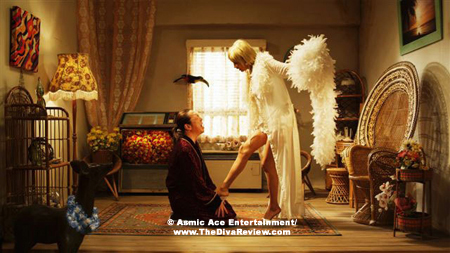 LMD:
Women are sort of the main motivation for each of the stories. Was that
in your mind when you created the screenplay? I almost saw the women as
different parts of the same character.
LMD:
Women are sort of the main motivation for each of the stories. Was that
in your mind when you created the screenplay? I almost saw the women as
different parts of the same character.
KM: Well, maybe itís part of life that men are constantly bewitched by women, {Laughs} so Iím glad you noticed the very attractive women in this film. Just as you said, you saw the women as multiple parts of one woman; I think you can say the same thing about the men, as well. Itís just one man played by eleven characters and they represent the laziness, the lostness, the silliness, as well as the sadness of the older gentleman.
LMD: What projects do you have coming up?
KM: Well, this is about a serious thought, but I was in the midst writing a screenplay when the earthquake hit. Post the earthquake; I felt that what I have been writing prior to that doesnít really depict what I want to say or what Iím feeling. So Iím sort of searching for what I really want to say right now, but a lot of my emotions, like a lot of Japanese people, havenít been really resolved or settled, so Iím waiting.
LMD: Do you think after the tragedy, perhaps the Japanese people need things right now that are happier or more uplifting to the spirit?
KM: Well, right now, I think a lot of the Japanese entertainment tends to go toward more escapist pictures -- more happy entertainment. What I was writing prior to the earthquake was about a single office lady, a businesswoman. It was about her finding a very small happiness in her daily life. But after the earthquake, I realised that the Japanese people have realised thereís so much happiness in just being alive. They didnít need a movie to realise that anymore. So Iíd like to find another way to give them a message now.
LMD: After your more serious project, are there any other comics you are reading that you would consider adapting for a live-action film?
KM: Actually, Iím reading this comic called Oyasumi Punpun. I love that comic book but the problem is the main character in that, Oyasumi Punpun, isnít a human being. Itís sort of a fictional character, so thatís going to be difficult to make into a movie.
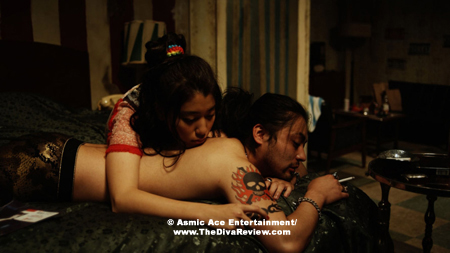 LMD:
What would you like audiences to take away from The Seaside Motel?
LMD:
What would you like audiences to take away from The Seaside Motel?
KM: First of all, I made this as an entertainment film, so as long as they laugh a lot for an hour and 40 minutes and have fun, thatís great. But if they wanted to go deeper, I would love them to see that one of the reasons I made this film is all the characters are sort of incomplete and kind of half-way there, and I really loved the process of showing how they sort of burst out of that. And metaphorically speaking, the Seaside Motel is a little superficial, as well; itís just an exterior, really. Thereís no ocean anywhere. But eventually, they bust out of the motel and they find a real ocean, so thereís some sort of bravery in that.
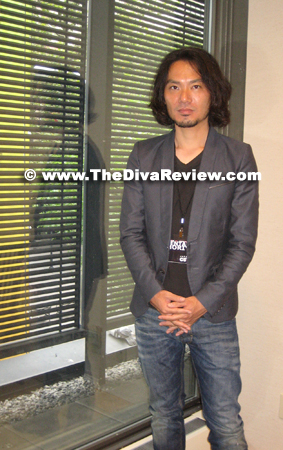 LMD:
Would you please give a message to our readers as to what to expect from
Kentaro Moriya in the future?
LMD:
Would you please give a message to our readers as to what to expect from
Kentaro Moriya in the future?
KM: I was a student when I came to New York City for the first time 22 years ago and since then; New York City has just been my favourite city. Iíve showed this film in Europe and Asia and Iíve traveled, but itís just so special to me, it means so much that Iím able to present this film today and right now, I could not be happier. After the screening, I would like to work hard to show another film in New York City. Thatís my goal. This is my true and honest feeling.
~ The Lady Miz Diva
July 16th, 2011
© 2006-2022 The Diva Review.com
|
|





















